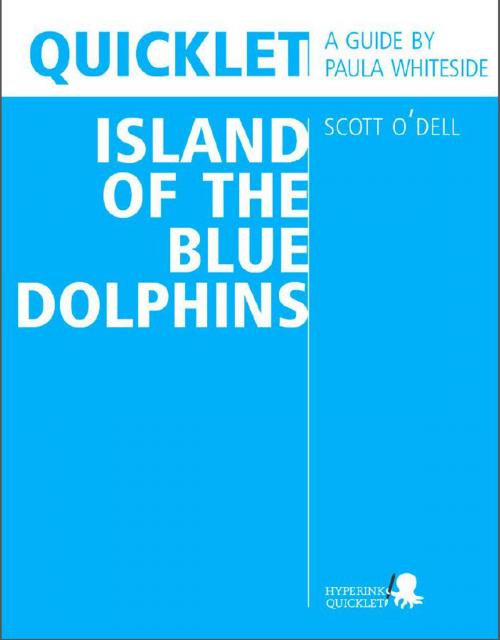Quicklet on Scott O'Dell's Island of the Blue Dolphins (CliffNotes-like Summary and Analysis)
Nonfiction, Reference & Language, Study Aids, Book Notes, Art & Architecture, General Art| Author: | Paula Whiteside | ISBN: | 9781614645207 |
| Publisher: | Hyperink | Publication: | July 30, 2012 |
| Imprint: | Hyperink | Language: | English |
| Author: | Paula Whiteside |
| ISBN: | 9781614645207 |
| Publisher: | Hyperink |
| Publication: | July 30, 2012 |
| Imprint: | Hyperink |
| Language: | English |
ABOUT THE BOOK
Island of the Blue Dolphins is the 1961 Newbery award-winning book by Scott O’Dell that tells the true story, with some literary license, of a young Indian girl named Karana who was left behind on San Nicolas Island off the California coast, along with her younger brother, after the remnants of their tribe are relocated on the mainland. The book is recommended reading for fourth graders in the California public school system due to its historical and cultural significance, as well as the fact that California fourth-graders, under state standards, are required to learn about the 21 Spanish Missions along the El Camino Real (The Royal Road) and their influence on the indigenous native-Americans during the 1800s.
Karana, also known as“The lone woman of San Nicolas Island,” is buried in an unmarked grave on the grounds of the Santa Barbara Mission where there is a plaque commemorating her. Students are encouraged to map out San Nicolas Island and research the various bird and marine life that Karana utilized to survive from 1835 to 1853.
Kids are invariably drawn to stories of self-sufficiency, without meddling parents and bedtimes. One need only look as far as the Baudelaire orphans in Lemony Snicket’s A Series of Unfortunate Events, or the survivalist skills in action of solitary Sam Gribley in My Side of the Mountain, to see kids’ fascination with life without parental involvement. However, O’Dell’s story draws a stark contrast to the plucky young heroes of absurdist literature or can-do fictional accounts, with its fact-based narrative of a life-and-death situation that played out for almost two decades.
However, despite the female protagonist’s strength, determination, and knowledge of Indian survival lore passed down over generations, the tragedy of the real-life character’s story goes unnoted by O’Dell and is indeed ironic. Within seven weeks of her rescue from the island and her arrival onto the mainland, “the lone woman of San Nicolas Island,” baptized “Juana Maria” by the Spanish missionaries, most likely succumbed to dysentery, a disease contracted through exposure to her numerous visitors and well-wishers. This is similar to the fate of Pocahontas, who likely contracted smallpox or tuberculosis after arriving in England from her native land of Virginia within a year.
O’Dell chose not to include the material concerning the girl’s tragic end in his original editor’s note, only commenting that, “The facts about her are few,” and comparing her to Robinson Crusoe. Indeed, the author’s purpose for writing the book was his boyhood interest in exploring Deadman’s Island off the Southern California coast around San Pedro. However, unlike Deadman’s Island, which was removed by dredging to improve the harbor at San Pedro, San Nicolas Island still remains and became a base of operations for missile testing systems from the 1970s up to the current day.
EXCERPT FROM THE BOOK
Scott O’Dell was born Odell Gabriel Scott to May Elizabeth Gabriel and Bennett Mason Scott on May 23, 1898 in Los Angeles, California. Due to a clerical error in one of his earlier written articles, the author was mistakenly referred to as “Scott O’Dell,” which he liked so much that he changed his name. O’Dell’s earliest recollections of Los Angeles was of “a frontier town” where “there were more jackrabbits than people,” most notable for its orange orchards and the port area. His father’s job with the railroad prompted the family, including younger sister Lucile, born in 1907, to move frequently around Southern California, including Claremont, populated by the descendants of Spanish settlers, and Julian...
...buy the book to read more!
ABOUT THE BOOK
Island of the Blue Dolphins is the 1961 Newbery award-winning book by Scott O’Dell that tells the true story, with some literary license, of a young Indian girl named Karana who was left behind on San Nicolas Island off the California coast, along with her younger brother, after the remnants of their tribe are relocated on the mainland. The book is recommended reading for fourth graders in the California public school system due to its historical and cultural significance, as well as the fact that California fourth-graders, under state standards, are required to learn about the 21 Spanish Missions along the El Camino Real (The Royal Road) and their influence on the indigenous native-Americans during the 1800s.
Karana, also known as“The lone woman of San Nicolas Island,” is buried in an unmarked grave on the grounds of the Santa Barbara Mission where there is a plaque commemorating her. Students are encouraged to map out San Nicolas Island and research the various bird and marine life that Karana utilized to survive from 1835 to 1853.
Kids are invariably drawn to stories of self-sufficiency, without meddling parents and bedtimes. One need only look as far as the Baudelaire orphans in Lemony Snicket’s A Series of Unfortunate Events, or the survivalist skills in action of solitary Sam Gribley in My Side of the Mountain, to see kids’ fascination with life without parental involvement. However, O’Dell’s story draws a stark contrast to the plucky young heroes of absurdist literature or can-do fictional accounts, with its fact-based narrative of a life-and-death situation that played out for almost two decades.
However, despite the female protagonist’s strength, determination, and knowledge of Indian survival lore passed down over generations, the tragedy of the real-life character’s story goes unnoted by O’Dell and is indeed ironic. Within seven weeks of her rescue from the island and her arrival onto the mainland, “the lone woman of San Nicolas Island,” baptized “Juana Maria” by the Spanish missionaries, most likely succumbed to dysentery, a disease contracted through exposure to her numerous visitors and well-wishers. This is similar to the fate of Pocahontas, who likely contracted smallpox or tuberculosis after arriving in England from her native land of Virginia within a year.
O’Dell chose not to include the material concerning the girl’s tragic end in his original editor’s note, only commenting that, “The facts about her are few,” and comparing her to Robinson Crusoe. Indeed, the author’s purpose for writing the book was his boyhood interest in exploring Deadman’s Island off the Southern California coast around San Pedro. However, unlike Deadman’s Island, which was removed by dredging to improve the harbor at San Pedro, San Nicolas Island still remains and became a base of operations for missile testing systems from the 1970s up to the current day.
EXCERPT FROM THE BOOK
Scott O’Dell was born Odell Gabriel Scott to May Elizabeth Gabriel and Bennett Mason Scott on May 23, 1898 in Los Angeles, California. Due to a clerical error in one of his earlier written articles, the author was mistakenly referred to as “Scott O’Dell,” which he liked so much that he changed his name. O’Dell’s earliest recollections of Los Angeles was of “a frontier town” where “there were more jackrabbits than people,” most notable for its orange orchards and the port area. His father’s job with the railroad prompted the family, including younger sister Lucile, born in 1907, to move frequently around Southern California, including Claremont, populated by the descendants of Spanish settlers, and Julian...
...buy the book to read more!















